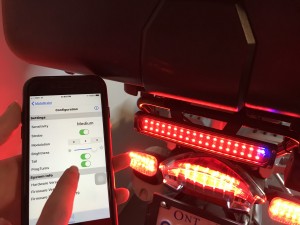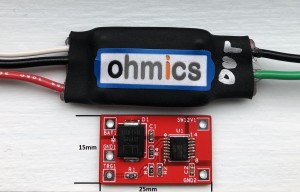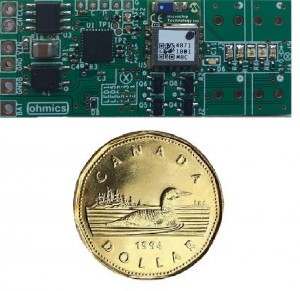MotoBrake Micro
The third generation MotoBrake is all FPGA-based and it is a smaller, brighter and sleeker.
Deceleration bike lights (US Patent US 10,363,865 B2) were one of my first moto-related designs. The first generation MotoBrake, in 2014, after two years of experiments and tuning, was the direct result of a comment my bike instructor made just before taking my exam, to make sure I tap my brake lights when I go off ramp, or I would fail the test.
Since, a lot of other manufacturers have added similar devices in the field. Mine were quite complex to operate and configure initially but worked well and since, I’ve tuned it more and with the help of newer sensors and Bluetooth technology, I tried to make them better, smaller, brighter and easier to use.
Features
|
|

MotoBrake Micro |

Bluetooth Setup |
MotoBrakeBT with Bluetooth Connectivity
The second generation MotoBrake with Bluetooth technology allowed configuration using a smartphone.
Smart LED Replacements for BMW Motorcycles Turn Signals
This isn’t a new idea but I really wanted to make it better. My bike is an old machine that needed some upgrades in terms of conspicuity so the natural thing to do was to add some Day-Running-Lights(DRL).
My design has progressive turn signals and slow-fading-in DRL, tail/brake cancellation for the duration of signalling (background cancellation feature), brightness control, brake modulation and are simple to install by adding one extra switched-12V wire to the turn signal enclosure as well as a brake signal (rear lights). And if the front double as DRL, then the rear set can double as brake light/tail light.
In addition, each set can be configured in multiple ways via local dip-switches to meet local regulations.
The front or rear sets will work with BMW bikes (and some Aprilia, Triumph and KTM models) ranging from 2000 to present.
This is a wiring example.
Front Set Features
|
|
| Rear Set Features |
 Round-shape for BMW models 2000-2014 Round-shape for BMW models 2000-2014 |
 Arrow-head for BMW models 2014-present Arrow-head for BMW models 2014-present |
|
Lattice LCMX02-4000HC-6QN84C Evaluation Board
Most of my basement-designs are based on Field Programmable Gate Arrays (FPGAs) devices and some require small physical devices with large logic slices and the Lattice LCMX02-4000HC-6QN84C was a prime candidate. Lattice does not offer an evaluation board for this exceptionally versatile device so… I designed one. MotoBrakeMicro was actually designed on this board, which also features a Microchip RN4871 Bluetooth module. The design schematics and the basic Verilog code that interfaces with an iOS app are free.
Features
|
MotoCAN – CANBUS Decoder
Motorcycle enthusiasts and developers have been trying to hack into their bikes every since CANBUS has been introduced by BMW or other European manufacturers. In the beginning, only the motorcycle sensors were on the bus but slowly, more and more messages have been added. When I decided that pinching my OEM cables to collect signalling from my bike for my added lighting was no longer fun, the idea of hacking my bike CANBUS was born. Sniffing the bike CANBUS codes, revealed that most functions I was looking for had corresponding CANBUS messages. Newer bikes will be slowly abandoning CANBUS in favor of the single-wire, cheaper LinBUS so the need to create decoders for both standards is even greater.
A great deal of recognition goes to ADVRider member “regnock” who’s done a ton of work in this field already.
| The MotoCAN decoder can be attached to any vehicle with a CANBUS system, but it was mainly designed for BMW motorcycles. The defaults are programmed to match my 2010 R1200GS but can be easily changed by navigating to this page, and picking the CANBUS messages matching a particular BMW bike and by entering them using the CANBUS coding interface in the MotoCAN iPhone app I wrote. The MotoCAN will detect brakes, turn signals, ignition and even existing buttons on your motorbike which can be re-purposed for other functions. For instance the ESA button has been re-purposed to turn on/off my auxiliary lights by having it pressed for more then 4 seconds in “Normal Mode”. |  |
12V, max. 20A – Switched Power for Motorcycle Accessories
With limited amount of power available thru a bike accessory plug, motorcycle enthusiasts have always resorted to adding accessories via other means ranging from simple relays to relay-arrays or complex power management units.
My solution is a single-port module, using a smart SSR chip (Solid State Relay) chip that incorporates all the necessary protections in a super small package.
Connection is simple: Black and Red wire connect to your battery directly. The White wire is the trigger and can be connected to any ignition-activated 12V wire (such as your 12V accessory plug). The Black and Green wires are your output to accessories offering you up to 20 amps per unit, for most demanding accessories.
Features
|

|
Downloads
|
| *Installation package includes Ohmics Pattern Designer, Firmware Upgrade Tool, and Windows Device Drivers. |
Reviews
Videos
| First MotoBrake launch, 2014 | My daughter testing first prototype, 2013 | MotoBrakeBT Configuration | MotoBrake Rev C | |
| MotoBrake RevC- 2016 | MotoBrake RevA-2015 | MotoBrake RevB on BMW R9T | Bicycle street run | |







